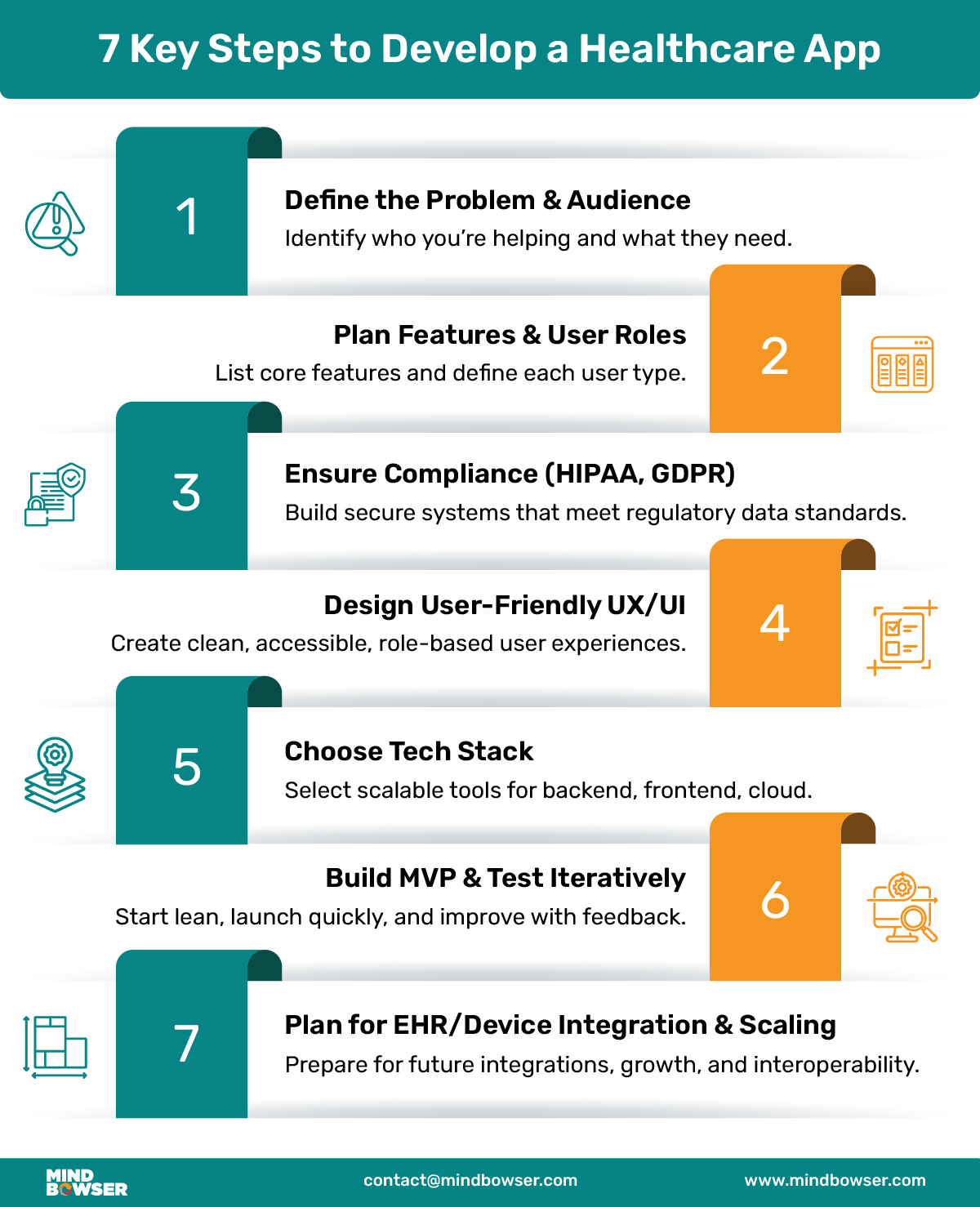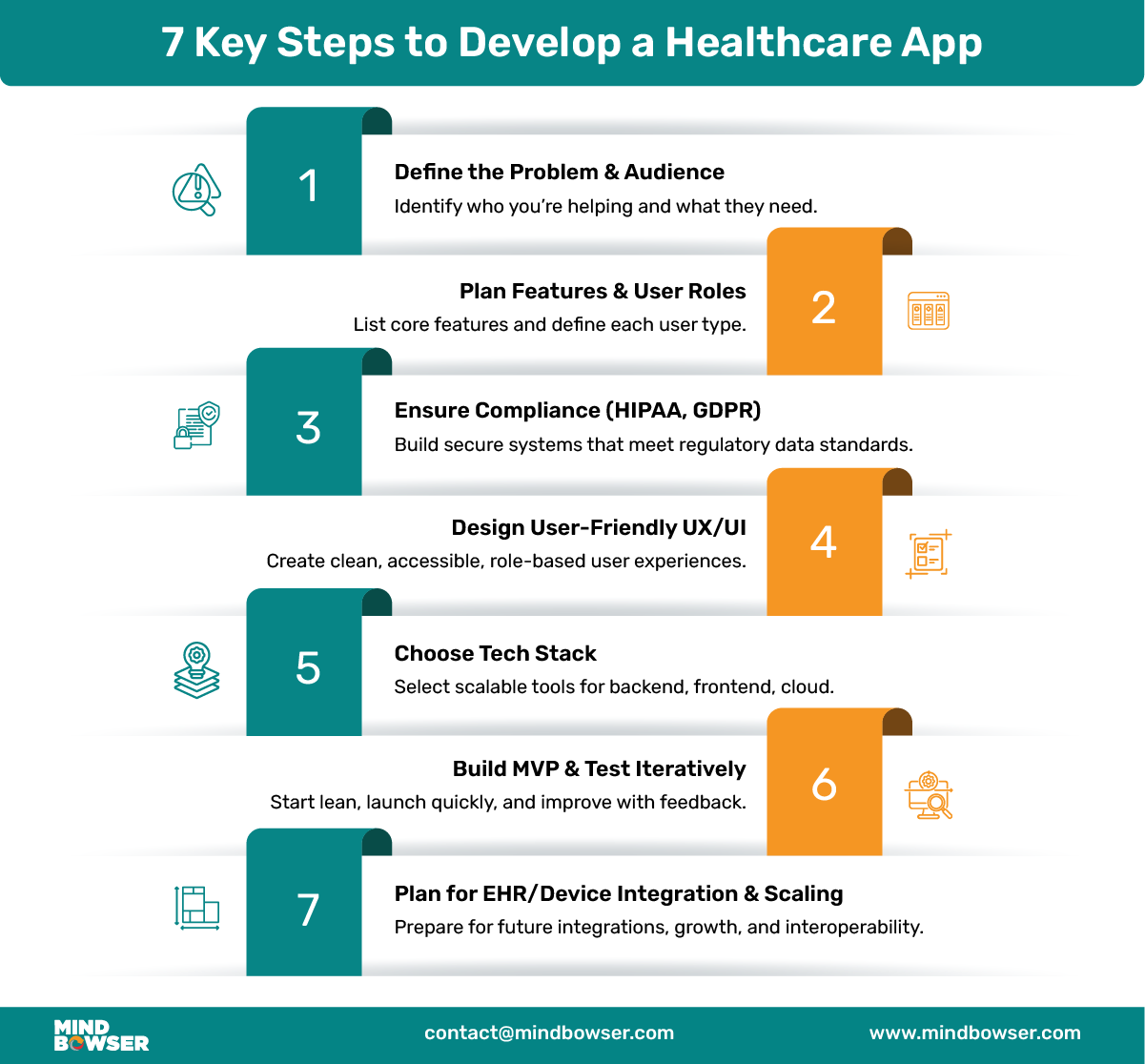The demand for mHealth apps has been on a steady rise, and it’s not just a post-pandemic trend. Patients want quicker access to care, doctors wish to have better tools to manage their workload, and healthcare systems seek smarter ways to close operational gaps. That’s where mobile apps are stepping in and proving their value.
But here’s the catch—knowing how to develop a healthcare app isn’t just about writing code or crafting a sleek design. You deal with real people, sensitive health data, and a highly regulated environment. Everything from the user interface to the backend infrastructure must be carefully planned. It won’t get adopted if your app doesn’t work for the patient or the clinician or fails to meet privacy requirements.
That’s why this guide walks you through the process of developing a healthcare app correctly, focusing on real-world decisions at every step. What kind of app should you build? How do you ensure compliance? What features matter most to users? Whether a clear path forward.
Before writing a single line of code, it’s important to understand what kind of healthcare app you’re building and how it aligns with current healthcare needs. If you’re figuring out how to develop a healthcare app that solves real problems, you’ll need clarity on use cases, user groups, and regulatory expectations.


Enable virtual consultations between doctors and patients. Common in primary care, mental health support, and follow-up care.
Remote Patient Monitoring (RPM)
Used for chronic disease management, these apps sync with wearable devices or connected health devices to collect and transmit patient data to healthcare providers.
EHR/EMR Companion Apps
Serve as extensions or interfaces to existing electronic health record systems, improving data access, usability, and speed for healthcare providers.
Wellness Apps
Focus on fitness, nutrition, or lifestyle habits. While they may not require full HIPAA compliance, they still manage sensitive personal data.
Include everything from meditation tools to therapy-on-demand platforms. The key is striking a balance between ease of use and emotional sensitivity while maintaining clinical reliability.
Related read: A Guide to Building Intuitive and Useful Healthcare Mobile Apps
Chronic Care Apps
Designed for specific conditions, such as diabetes, hypertension, or asthma. They often include progress tracking, reminders, educational content, and alerts.
Understanding these categories is a crucial first step if you’re serious about developing a healthcare app that meets real clinical and patient needs in 2025.
Healthcare tech isn’t static. Today’s successful apps reflect where the industry is going:
Whether you’re building for patients, doctors, or administrators, some things are non-negotiable:
Understanding this landscape helps you build with purpose. It’s not about cramming every feature into your app—it’s about solving the right problem for the right people, at the right time.
Related read: Top 10 Digital Healthcare Trends HealthTech Founders Must Watch in 2025
One of the biggest reasons healthcare apps fail isn’t poor tech—it’s poor focus. Before jumping into development, take a step back and ask the most important question: What problem are you trying to solve, and who exactly are you solving it for?
The best healthcare apps are built around a clearly defined clinical or patient need. You might be:
If you can’t clearly describe the pain point your app addresses, you’re already off course.
Once the problem is clear, zoom in on your audience. The user experience of a nurse managing shifts is vastly different from that of a diabetic patient tracking their blood sugar.
Here are a few user types to consider:
Map out how each user interacts with your app and what they expect from it.
Healthcare is full of apps that promise a lot but deliver little. A strong competitive analysis can help you:
Look closely at 3–5 direct competitors. Test their apps. Read user reviews. Figure out what they’re missing, and decide how your app will do it better or differently.
Once you’ve identified the problem and your target audience, the next step is to define what your app will do. This is where many healthcare projects either become overly complex or fail to meet expectations. You don’t need every feature under the sun—you need the right features that match your use case and users.
Your app’s core features should address the primary problem you set out to solve. Depending on the goal, this might include:
Always think from the user’s point of view—what’s the one thing they need to do quickly and without friction?
In addition to user-facing features, you’ll need a way to manage the backend:
If your app supports multiple user types, ensure that their features and interfaces are separated and streamlined.
This is where healthcare app development can become complex, yet also powerful.
While you may not need these from day one, plan for them early if they’re in your future roadmap. It’s easier to build on a prepared foundation than to retrofit integrations later.
Related read: EHR Integration: Why It’s Essential for Healthcare Data Management
In healthcare, compliance isn’t a nice-to-have—it’s a must-have. If your app collects, stores, or transmits any health-related data, you’re automatically in the world of regulations. And failing to meet them can kill your product before it even launches.
Depending on where your users are located and what your app does, you’ll need to align with one or more of the following:
If you’re unsure whether your app requires FDA clearance, it’s best to consult with your legal or regulatory team early on.
At a practical level, compliance touches almost every part of your app:
Even experienced dev teams can fall short if they haven’t worked in healthcare. It’s critical to work with a team that understands how to build security into the architecture, not just bolt it on later.
Documentation also matters. From risk assessments to privacy policies and business associate agreements (BAAs), your paper trail should be as strong as your codebase.
Related read: The Role of HIPAA Business Associate Agreements in Ensuring Compliance
In healthcare, design isn’t just about aesthetics—it’s about clarity, trust, and usability. A confusing or cluttered interface can frustrate users, delay care, or worse, lead to clinical mistakes. That’s why good design in a healthcare app is non-negotiable.
Your app needs to work for everyone, not just tech-savvy users. That means:
The goal is to make sure no user is left out, regardless of age, condition, or device.
Your design needs to reflect the daily reality of your users. For example:
Try mapping out the user journey for each role. Where are they? What are they trying to do? How much time do they have? The answers to these questions should inform your interface design.
Most users today will access your app from a mobile device, especially patients. So, your core experience must feel intuitive on a smartphone. However, clinicians may log in via tablets or desktops, so your design needs to scale smoothly across different screen sizes.
Don’t just “shrink” the desktop view. Design each version with purpose and prioritize what matters most for each context.
Your tech stack isn’t just a technical decision—it directly affects your app’s performance, scalability, security, and even how quickly you can go to market. Choosing the right tools from the start helps you avoid roadblocks later on.
You’ll first need to decide how to build your mobile app. There are two main approaches:
Tip: If your app needs access to wearables or camera/video SDKs, check compatibility early on.
This is where your app logic, database, and APIs live. Some commonly used stacks for healthcare apps:
Pair your backend with a reliable cloud platform like:
All three offer HIPAA-compliant infrastructure if configured properly.
You don’t need to build every component from scratch. Some plug-and-play tools worth evaluating:
Make sure any third-party service you use is either HIPAA-compliant or doesn’t handle PHI.
In healthcare, building a full-scale product from the ground up is usually a mistake. Regulations, user feedback, and integration challenges—there’s a lot that can shift once the app is in the hands of real users. That’s why starting with a Minimum Viable Product (MVP) is not just smart—it’s necessary.
An MVP isn’t a half-baked version of your app. It’s a focused version that solves a specific problem cleanly and reliably.
Waterfall methods are not well-suited for healthcare app development. Agile lets you:
Use short development sprints, followed by reviews with stakeholders. Involve clinicians or domain experts regularly—they’ll point out usability or workflow issues that may not be obvious to your tech team.
Once your MVP is live:
Let data and user input guide what comes next—whether it’s deeper integrations, new features, or workflow enhancements.
If your app needs to retrieve clinical data, push patient updates, or synchronize with hospital records, EHR/EMR integration is a crucial component of the puzzle. Done right, it saves time for clinicians and builds trust in your platform. Done poorly, it creates friction that can kill adoption.
Most hospitals or health systems already use platforms like Epic, Cerner, Athenahealth, or Allscripts; your app needs to integrate with them.
You don’t need to build custom APIs from scratch. Use established standards:
These standards are not just technical—they also come with security expectations, data schemas, and real-world workflow implications.
Tip: If EHR integration isn’t a priority in your MVP, at least build your app’s backend with it in mind, so when you’re ready, you don’t have to restructure everything.
Related read: Checklist for EHR Integration in the Healthcare System
Even with the best intentions and the right team, it’s easy to fall into common traps when building a healthcare app. These mistakes don’t just slow you down—they can jeopardize adoption, security, and even compliance.
Many teams assume they can “add HIPAA later.” That’s a costly mistake. Compliance affects your architecture, data handling, documentation, and third-party services. Trying to retrofit it later leads to rework and missed deadlines. It’s far better to design your app with privacy and security baked in from day one.
It’s tempting to add every nice-to-have: appointment booking, chat, AI, reminders, wellness tracking, dashboards… all at once. But in healthcare, clarity and performance matter more than quantity. A bloated app confuses users and makes testing and compliance harder. Focus on solving one clear problem well before scaling up.
Whether it’s patients, doctors, or care coordinators—if you’re not building with their input, you’re building in the dark. Too often, apps are launched without validating the workflow with real users. This leads to poor adoption, constant change requests, or even clinical rejection.
Instead, bring users in early. Let them test wireframes, click-through flows, and provide feedback during development—not after launch.
At Mindbowser, we’ve helped dozens of healthcare startups and organizations take their app ideas from concept to launch—and beyond. Whether you’re building a HIPAA-compliant telehealth platform, integrating with Epic or Cerner, or creating a remote monitoring tool with wearable data, we’ve done it.
Here’s how we support you:

Building a healthcare app in 2025 isn’t just about writing good code. It’s about solving real problems in a space where user trust, privacy, and usability are non-negotiable. From choosing the right type of app to planning features, ensuring compliance, and designing for real-world users, every step you take shapes the success of your product.
Start with a clear problem. Build a lean, secure MVP. Listen to your users. And plan for growth with the right technology and integration paths.
If you’re building your first healthcare app—or looking to improve an existing one—the smartest move is to surround yourself with people who understand both tech and healthcare.
It depends on the complexity of the app, but an MVP (Minimum Viable Product) typically takes 10–16 weeks. This includes design, development, compliance setup, and testing. If you’re integrating with EHR systems or adding custom features, it may take longer.
If your app collects, stores, or transmits protected health information (PHI) in the U.S., then yes—HIPAA compliance should be factored in from the start. It impacts how your backend is built, how data is encrypted, and which third-party tools you can use.
Yes, but EHR integration requires planning. Most modern systems use FHIR or HL7 standards, and you’ll need to align with their APIs and security protocols. It’s best to work with a team that has done this before to avoid roadblocks.

We worked with Mindbowser on a design sprint, and their team did an awesome job. They really helped us shape the look and feel of our web app and gave us a clean, thoughtful design that our build team could...


The team at Mindbowser was highly professional, patient, and collaborative throughout our engagement. They struck the right balance between offering guidance and taking direction, which made the development process smooth. Although our project wasn’t related to healthcare, we clearly benefited...

Founder, Texas Ranch Security

Mindbowser played a crucial role in helping us bring everything together into a unified, cohesive product. Their commitment to industry-standard coding practices made an enormous difference, allowing developers to seamlessly transition in and out of the project without any confusion....

CEO, MarketsAI

I'm thrilled to be partnering with Mindbowser on our journey with TravelRite. The collaboration has been exceptional, and I’m truly grateful for the dedication and expertise the team has brought to the development process. Their commitment to our mission is...

Founder & CEO, TravelRite

The Mindbowser team's professionalism consistently impressed me. Their commitment to quality shone through in every aspect of the project. They truly went the extra mile, ensuring they understood our needs perfectly and were always willing to invest the time to...

CTO, New Day Therapeutics

I collaborated with Mindbowser for several years on a complex SaaS platform project. They took over a partially completed project and successfully transformed it into a fully functional and robust platform. Throughout the entire process, the quality of their work...

President, E.B. Carlson

Mindbowser and team are professional, talented and very responsive. They got us through a challenging situation with our IOT product successfully. They will be our go to dev team going forward.

Founder, Cascada

Amazing team to work with. Very responsive and very skilled in both front and backend engineering. Looking forward to our next project together.

Co-Founder, Emerge

The team is great to work with. Very professional, on task, and efficient.

Founder, PeriopMD

I can not express enough how pleased we are with the whole team. From the first call and meeting, they took our vision and ran with it. Communication was easy and everyone was flexible to our schedule. I’m excited to...

Founder, Seeke

We had very close go live timeline and Mindbowser team got us live a month before.

CEO, BuyNow WorldWide

Mindbowser brought in a team of skilled developers who were easy to work with and deeply committed to the project. If you're looking for reliable, high-quality development support, I’d absolutely recommend them.

Founder, Teach Reach

Mindbowser built both iOS and Android apps for Mindworks, that have stood the test of time. 5 years later they still function quite beautifully. Their team always met their objectives and I'm very happy with the end result. Thank you!

Founder, Mindworks

Mindbowser has delivered a much better quality product than our previous tech vendors. Our product is stable and passed Well Architected Framework Review from AWS.

CEO, PurpleAnt

I am happy to share that we got USD 10k in cloud credits courtesy of our friends at Mindbowser. Thank you Pravin and Ayush, this means a lot to us.

CTO, Shortlist

Mindbowser is one of the reasons that our app is successful. These guys have been a great team.

Founder & CEO, MangoMirror

Kudos for all your hard work and diligence on the Telehealth platform project. You made it possible.

CEO, ThriveHealth

Mindbowser helped us build an awesome iOS app to bring balance to people’s lives.

CEO, SMILINGMIND

They were a very responsive team! Extremely easy to communicate and work with!

Founder & CEO, TotTech

We’ve had very little-to-no hiccups at all—it’s been a really pleasurable experience.

Co-Founder, TEAM8s

Mindbowser was very helpful with explaining the development process and started quickly on the project.

Executive Director of Product Development, Innovation Lab

The greatest benefit we got from Mindbowser is the expertise. Their team has developed apps in all different industries with all types of social proofs.

Co-Founder, Vesica

Mindbowser is professional, efficient and thorough.

Consultant, XPRIZE

Very committed, they create beautiful apps and are very benevolent. They have brilliant Ideas.

Founder, S.T.A.R.S of Wellness

Mindbowser was great; they listened to us a lot and helped us hone in on the actual idea of the app. They had put together fantastic wireframes for us.

Co-Founder, Flat Earth

Mindbowser was incredibly responsive and understood exactly what I needed. They matched me with the perfect team member who not only grasped my vision but executed it flawlessly. The entire experience felt collaborative, efficient, and truly aligned with my goals.

Founder, Child Life On Call

The team from Mindbowser stayed on task, asked the right questions, and completed the required tasks in a timely fashion! Strong work team!

CEO, SDOH2Health LLC

Mindbowser was easy to work with and hit the ground running, immediately feeling like part of our team.

CEO, Stealth Startup

Mindbowser was an excellent partner in developing my fitness app. They were patient, attentive, & understood my business needs. The end product exceeded my expectations. Thrilled to share it globally.

Owner, Phalanx

Mindbowser's expertise in tech, process & mobile development made them our choice for our app. The team was dedicated to the process & delivered high-quality features on time. They also gave valuable industry advice. Highly recommend them for app development...

Co-Founder, Fox&Fork
